Chris Baty's Blog, page 156
October 28, 2015
Come Write In: How Writing Creates Powerful Experiences
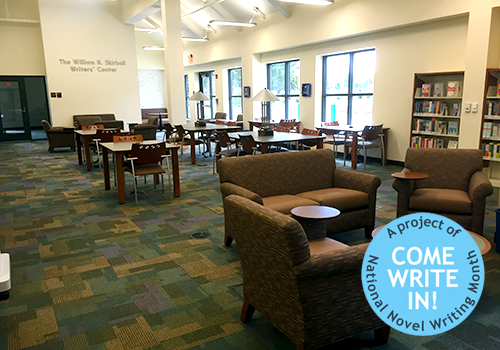
Our Come Write In program provides libraries, bookstores, and other neighborhood hubs the resources to build and support a local writing community. We dig through the stacks to bring you our favorite stories: today, Laurie Kincer at the Cuyahoga County Public Library in Ohio shares how NaNoWriMo creates an emotionally powerful experience:
NaNoWriMo 2015 is the ninth year that Cuyahoga County Public Library has partnered with our Cleveland area Municipal Liaison. We co-host Write-Ins every Saturday in November, as well as a Kick-Off event and a Thank Goodness It’s Over Party. CCPL has 27 branches throughout the county, so we typically choose a central location for the October and December events and then alternate between west and east side branches in November.
Last year we tried something that worked so well that we’ll be doing it again this year. For the Kick-Off, our ML pulled together a panel of four Wrimos, each of whom shared how they accomplished writing 50,000 words in one month. They answered questions, gave great advice and were incredibly inspiring…
This year’s Kick-Off will be creating a little bit of history, too. It will be the very first writing program in the brand new William N. Skirball Writers’ Center at the new South Euclid-Lyndhurst Branch, set to open October 18th. It’s one of only a handful of public library-based writers’ centers in the nation.
“Inspire, empower and connect with writers…”
NaNoWriMo is the perfect way to
Promote writing, creativity and self-expression,Inspire, empower and connect with writers, and
Create a supportive and engaged community of writers.
The memory that sticks with me most is from last year’s Kick-Off panel. One of the Wrimos explained that after she finished her novel, she revised it and printed the free copies that are a perk of reaching the 50,000-word mark. She donated one to her library. At the panel she talked about how, when she and her children went to the library, she showed her children her book on the shelf in the library. She was so proud. It reminded me how emotionally powerful NaNoWriMo can be.
“Write-Ins are an easy, win-win way to partner.”
If you’re a library or community center getting ready for NaNoWriMo, get in touch with your ML now. If your library is like ours, you’ll be planning for NaNoWriMo in the spring, so you need to be able to make plans with your ML at least six months before November 2016.
Write-Ins are an easy, win-win way to partner. At our Write-Ins, the ML attends and leads the event while the library supplies the meeting room, tables, chairs, extra extension cords and power strips. Both the ML and the library promote the program through our different channels.
Try a panel of Wrimos at your Kick-Off and, if possible, offer snacks so that people can hang around and talk after the panel. They’ll have a lot to talk about!

Laurie Kincer, M.A., M.L.I.S., is the Writers’ Center Coordinator for Cuyahoga County Public Library. Because writers learn from other writers, she is also involved in bringing authors to visit the Library, including, this fall, novelists Geraldine Brooks, Adriana Trigiani and Jill Bialosky. Laurie is constantly scouting for authors, writers, and new ways to engage and inspire the writing and reading community.
October 27, 2015
Road Trip to NaNo: Why Your Unique Experiences Matter for Creativity
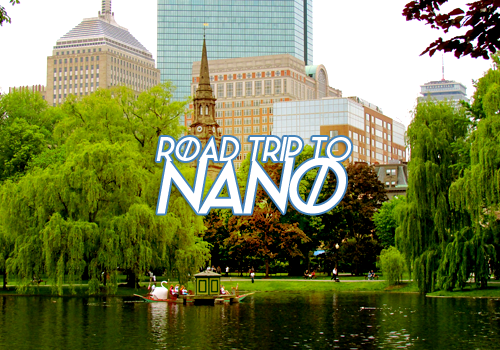
NaNoWriMo is an international event, and the stories being written every year reflect our hundreds of participating regions. We’re taking a Road Trip to NaNo to hear from our amazing writers all around the world. Today, Travis Kelley, our Municipal Liaison in the Boston region shares why the diversity of NaNoWriMo participants is a source of creative inspiration:
Boston is a city of learning. With more than 50 accredited colleges and universities in our metropolitan region, you only need to spend a few minutes here to realize what a vital role education plays here. This also makes National Novel Writing Month a tremendously diverse experience.
Write-ins in Boston have an incredible cross-section of people. A college professor may be sitting next to an émigré from France and across from a high school student. Yet the thing they have in common—noveling!—brings them together. In Boston, we take shameless advantage of the breadth and depth of the experiences of our participants…
We have each person contribute a writing prompt on an index card at our Meet & Greet/Kickoff Party. This stack of prompts then comes with us to all of our regional events, ready and waiting for the writer who is stuck. Many folks contribute more than one prompt.
My propensity for telling outrageous stories, making stupid jokes, and tossing out groan-inducing puns at NaNoWriMo events is, depending on the person, either legendary or infamous. Every year, someone always includes in their prompt “Write Travis into your story. Then try to write him out again.”
I’m proud to have, in my own twisted way, been killed off several times, inspired thousands of words to be written, and once, even won the heart of the handsome hero. It’s heady stuff, being a meme.
I’ve benefited so much from the wide range of people and experiences in one room during a write-in. My writing method is character driven; my characters exist in my head before I know how I want the story to turn out. Being able to dive into a stack of writing prompts can be invaluable to me when I get stuck, as badly thought-out characters will do from time to time, and lets me avail myself of a little of the creativity present.
At a write-in, you may find an expert in the most unlikely area sitting across from you. When you have an early childhood education expert, attorney, concierge, crafter, call-center worker, social worker, sailor, a couple of librarians, and a published author in one room, all ready and willing to offer help and suggestions, there is no way you can’t benefit just a little.
There is a humorous axiom that states “you are unique—just like everybody else.” As a participant in this worldwide phenomenon, you bring to the table a unique history, experiences, and mindset. Don’t be afraid to share your uniqueness to help others improve their craft, and don’t be afraid to ask others to help you improve yours. Your writing prompt, thought or suggestion, or even just the fact that you listened to somebody discuss their problem, may help another writer.
There are no losers in National Novel Writing Month, but you could be the reason that there is another winner.

Travis Kelley is a journalist by education, a military public affairs specialist by training, photographer by choice, and a concierge by necessity. He defies convention, exceeds expectations, and foments frustration, occasionally all at the same time. He compulsively makes lists.
Top photo by Flickr user Jeff Gunn.
October 26, 2015
3 Steps to Rev Up Your Writing Momentum

NaNo Prep season is coming to an end; November is just around the corner! We’ve asked writers to share their best tips on how to write the first draft of a novel and have fun doing it. Today, author Melanie Sumner shares how to anticipate and prepare against a writing stall:
Here’s one possible scenario when November arrives: Your novel starts with a vroom! You’re cruising along, and then… the darn thing dies on you. Is this normal? Absolutely. Here’s what you can do to rev it back up.
First, congratulate yourself.You’ll have started a novel, something many people having been meaning to do for a long time. With words on a page or screen, you’ll have hurdled the most difficult obstacle—the blank space. Energy creates energy, so anything you’ll have written will feed your progress…
I believe that we stop writing because we get bored. No matter what else is happening in your life, if you are into the story, it will sing along in your head, getting in the way of everything else until you scribble it down. To rekindle your initial excitement, look for the “vein” in your story. You do this the way a nurse does when she’s poking around your arm with a needle, trying to draw blood. Who is your favorite character? Which character makes you angry? Can you find a conversation that got so heated you forgot to add tag lines? Do you remember an hour when you forgot you were writing? Find that spot and write from it.
But what about my outline?I love outlines—mostly as excuses not to write. When I start adding complex graphics, I know I’m in trouble. For now, tell your outline to take a nap.
Grab that juicy vein in your story (if you haven’t found it, ask a friend to look), and write five hundred words about it, preferably without stopping. Make the blood flow!
Yes, this is messy. When your inner critics call a board meeting, put them to bed with your outline. Don’t worry if this offends them — it will — but you’ll call them back for the revision. For now, you are in revolt. Write down something you don’t dare write. Write it on the wall, in blood-red permanent marker.
All revved up but still short on today’s word count? It’s time to sweat.This is like when you’re tired, and your trainer tells you to do fifty more push ups. Do whatever is necessary — break that fifty into five sets of ten; promise yourself an ice cream cone afterwards; whine your head off. Just do it.
Now you have the power because something about your story is hot. Make it even hotter.

Melanie Sumner is the author of the novels, How to Write a Novel , The Ghost of Milagro Creek , and The School of Beauty and Charm as well as a short story collection, Polite Society . She has received the Whiting Writers’ Award and a fellowship from The National Endowment for the Arts. Find her on Twitter at: @sumnermelanie
Top photo by Flickr user cheerytomato.
October 24, 2015
NaNo Coach: 7 Essential Questions for Your Characters

All through National Novel Writing Month, published authors will take the whistle, take over our official Twitter account for a week, and act as your NaNo Coach, offering advice, encouragement, and pep. Our first NaNo Coach,
Randy Ribay, author of An Infinite Number of Parallel Universes, wraps up his time with some final words on character:
With November quickly approaching, many of you are probably starting to outline your plot. I imagine the planners among you are neurotically filling notebooks (or Scrivener) with maps, color-coded notes, pictures, and complex charts, while the pantsers are chilling out as story ideas simmer in their minds. (And a good number of you might just be freaking out about how clueless you are.)
Whichever route you take, don’t spend so much time figuring out what is going to happen in your story that you overlook who is in your story. Ultimately, stories are about people—or talking creatures or robots—and how they react to difficult situations. Strong characters will drive the plot and give your reader someone to root for.
Though standard character questionnaires/profiles might be your jam, they haven’t helped me much in understanding what’s truly important about my imaginary friends. Below is a list of seven essential questions that I think will help you develop a useful base for your main characters before November hits:
What single aspect of background (nationality, ethnicity, family, etc.) impacted your character the most?When your character looks in the mirror, what is the first thing s/he thinks about?
What is your character’s best personality trait—and how can it also be a flaw?
What does your character value the most?
What does your character fear the most?
What does your character want, and why can’t s/he get it?
What is your character’s biggest secret?
The more deeply you know your characters, the better you’ll understand what they’ll say or do in any given situation. Not only can this help prevent writer’s block down the road, but I think it leads to a truer and more organic story.
And try not to stress out too much if your imaginary friends feel flat initially. The more you write about them, the more you’ll learn about them. Think of your first draft as your first date.
Randy Ribay was born in the Philippines and raised in Michigan and Colorado. He is a graduate of the University of Colorado and the Harvard Graduate School of Education, where he specialized in language and literacy. He is the English Department Chair at an all-boys high school in Philadelphia and a nerd-of-all-trades. Randy lives in Camden, New Jersey with his wife and two dog-children.
October 23, 2015
Young Writer Chronicles: Why Writing More Helps Students Write Better
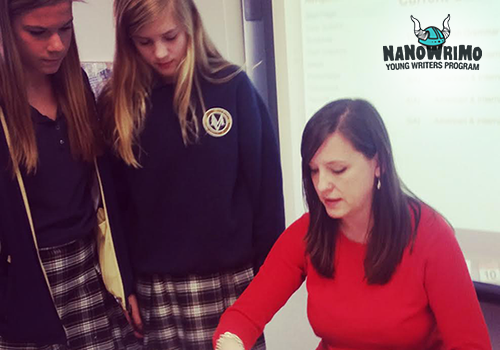
Every November, our Young Writers Program works with 100,000 students and educators, and 2,000 classrooms around the world. Today, Marie Graham, educator at
Mount Vernon Presbyterian School in Atlanta, Georgia, shares just how much NaNoWriMo teaches her students:
My principal had mentioned NaNoWriMo to me in 2012, but it felt daunting. I mean, who thinks about 7th graders writing books? I certainly didn’t. Paragraphs seemed like quite enough, and even those were challenging sometimes, so I initially skipped it, but what I did do was pop in on the NaNoWriMo website and follow along. I was inspired by the energy and the community I saw. The more I read, the more excited I became…
I teach at a school, Mount Vernon Presbyterian (Atlanta, Georgia), whose culture is steeped in experimenting, innovating, and wondering. This allows students and teachers to follow their curiosity and not be scared of failing. In fact, failing is celebrated. That is so freeing!
When the next year came along, I was onboard. My students were floored, speechless even. I was emphatic, though; we were all (without exception) going to be novelists, and (gulp) we were writing the novel in one month. I believe in self-fulfilling prophesy. What a teacher believes to be true, often is, so I made myself believe that we all could do it, and we did.
“Every single student in here is going to be a novelist. Each one of you have stories waiting to be told.”
I know from the last two years of teaching NaNoWriMo that the idea of writing a novel should be unfolded in the weeks before the challenge begins. In October, I tell my students that they will have the opportunity to do something that most people at the end of their lives cannot say they have done. I explain that the challenge will be exciting and difficult at times.
Then, I dramatically pause and say, “Every single student in here is going to be a novelist. Each one of you have stories that are waiting to be told. The secret is that only you can tell the story. The characters are buried in your minds and are just waiting to come to life.”
My students are so excited. Every day they want to discuss their ideas, themes, genres. Questions are popping up about how to punctuate dialogue, how to describe settings. These questions are arising organically from 12 year olds!
 “…the more a student writes, the better he or she writes.”
“…the more a student writes, the better he or she writes.”Teachers empirically know that the more a student writes, the better he or she writes. The quantity of writing itself directly affects fluency, and fluency is more than half of the battle. When students see relevance—that they are not just writing for me, that they are writing a novel that may be read by many others, that will be printed (paper or digital)—they are inspired to write. It is real work, not play work. That affects motivation greatly.
I had a student last year who found writing challenging. He struggled to put his ideas and thoughts on paper. I think I probably worried somewhat about him as we approached November, but I tried hard to cast away any doubts and assuaged his worries with “You will write a novel one word at a time. You will complete this.”
He ended up writing 35,000 words. I am still shocked even as I write this now. He wrote and wrote and wrote. The more he wrote, the more excited he was at his own progress, and his writing just naturally took off. It was almost like a dam of words in his mind was breached.
“NaNoWriMo naturally teaches grammar, punctuation, and writing skills.”
Mostly, I have to say that NaNoWriMo naturally teaches grammar, punctuation, and writing skills. Students come to me with specific questions, and they literally ask for instruction. Their learning becomes personal.
If you’re thinking of teaching NaNoWriMo (or even just participating), do it! All of your learning outcomes are buried in this one big assignment. Everything can be taught within this challenge. It creates a community of writers that cheers each other on and leaves students forever changed.
I suggest that you get started early, have a kick-off party, and build up the excitement. If you can write with them, do. Learn beside your students; let them watch you struggle and persevere.
Of all of the activities I have ever done with students, I think NaNoWriMo has been the most impactful, and not just the skill sets or even the pride they feel at the end—it is the belief and knowledge that one is able to accomplish a goal that seems so formidable at first. I hope that confidence will stay with them the rest of their lives. I feel good about being even a small part of that.

Marie Graham is a middle school history and English teacher at Mount Vernon Presbyterian School in Atlanta, Georgia; an avid, insatiable learner; mother; collage artist; fiction writer; certified nurse-midwife; Virginian; and lover of Rumi, C.S. Lewis, & 80s music.
October 22, 2015
Road Trip to NaNo: Find Your Story Where No One Else Is Looking
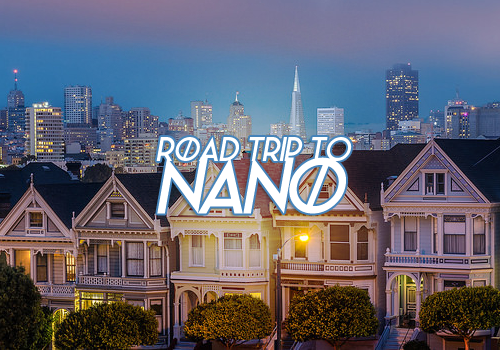
NaNoWriMo is an international event, and the stories being written every year reflect our hundreds of participating regions. We’re taking a Road Trip to NaNo to hear from our amazing writers all around the world. Today, Barrington Lloyd-Lovett, our Municipal Liaison in the San Francisco region challenges you to look for stories where no one else is looking:
San Francisco is a defining city. I don’t mean that San Francisco defines anything directly. I mean that concepts, movements, and industries are defined in and by San Francisco.
The Mission burrito? San Francisco. Gay marriage? (Largely and vocally) San Francisco. Tech companies? SF, my friend. All of these and more were defined or developed in our lovely city and the surrounding area, and that’s something to be proud of…
Having transferred here as an outsider, I’m continually impressed by the determination and resilience of the natives and adopted residents to have their stories heard.
I get the sense that San Francisco is a place where one can come with an idea and make it a true reality. The concentration of innovators, writers, artists, thinkers, and collaborators seems higher here. It’s almost as if the ether—and the weather—are conspiring to bring great minds to the Bay, where we can work together to figure out exactly what the city wants in order to thrive.
The most interesting part for me has been letting go of what I think the city needs, and writing the stories that come. This is the kind of city that tells its own story. It’s easy to get sidetracked by what seems important on the outset—housing, taxes, and business all have their distracting pull, but the city is so much more than just those few things.
Even without diving into the history of San Francisco, there’s so much potential in the grit of the neighborhoods. Each neighborhood has its own feel, a distinct pulse. Finding a way to tap into that pulse is a sure shot into a story, especially a story that no one else can tell. You can see what others can’t when you’re looking where no one else will.

Barrington Lloyd-Lovett is unnecessarily excited by video games, and doesn’t write enough, even though he writes too much. He loves Persian literature (in the original language), watches not-quite-enough soccer, and generally enjoys good food and wine. He also plays musical instruments, most notably the piano.
Top photo by Flickr user Michael Muraz.
October 21, 2015
Come Write In: How to Build a Writers’ Community
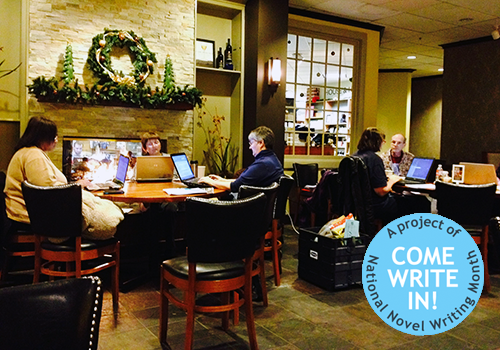
Our Come Write In program provides libraries, bookstores, and other neighborhood hubs the resources to build and support a local writing community. We dig through the stacks to bring you our favorite stories: today, Jennifer Mattox at the Carnegie Center for Literacy and Learning shares why partnering with bookstores and libraries to promote writing matters:
The Carnegie Center for Literacy and Learning is a community learning and literary arts center in Lexington, Kentucky, and NaNoWriMo fits perfectly into our mission: to empower people to explore and express their voices through imaginative learning and the literary arts.
As a Come Write In site, we encourage writers to meet in groups or individually to write their novels. Our Writers Reference Room has bookshelves full of valuable resources devoted to the craft of writing, and a library table and desks just perfect for the aspiring writer. Wrimos are welcome and encouraged to write here anytime we are open Monday through Saturday, and they are free to bring food and drinks with them if they want to make a day of it…
The Carnegie Center also publicizes NaNoWriMo in our fall workshop brochure and on a flyer that lists local NaNo activities so that writers can know where to find support. Our building is the home site for the Lexington, KY NaNoWriMo group to meet for “NaNoPlano” prior to November. People who are new to National Novel Writing Month and people who have been through it before meet to discuss upcoming activities, get to know one another, and provide encouragement.
On Writing Workshops, Overnight Write-Ins, and Secret AuthorsThe Carnegie Center offers writing workshops and seminars each season, so it was easy to add one specifically for NaNoWriMo participants called “How to Write a Novel in 30 Days.” As a multi-year NaNoWriMo winner, I lead this seminar, and include strategies for meeting word count, writing a quick first draft, and keeping track of your storyline and characters. I also lead this seminar in a local bookstore and, at times, in Central Kentucky libraries—including 2013, when Kentucky public libraries chose NaNo-novel The Night Circus by Erin Morgenstern as their One Book, One Bluegrass selection.
For the past two years, we partnered with Joseph-Beth Booksellers to host an Overnight Write-In event in their store. Wrimos arrived an hour before the store closed, and after a welcoming session and some appetizers, got down to business. Then when the store closed, they stayed, finding comfy spots to write in the Bistro near the fireplace, on a couch in the store, or in a private corner tucked behind a row of bookshelves.
The local MLs got on the store’s intercom system to start and stop writing sprints periodically through the night, and there was an optional group session where Wrimos could come together and discuss what was working and what wasn’t with their NaNo-novel. Hot coffee was available all night, and there were breaks for sandwiches and breakfast foods to keep people going into the morning hours.
“They loved discovering that a published NaNoWriMo author was there among them, writing through the night.”
Last year at the Overnight Write-In, I served as host and during the welcoming announcements revealed that one of the Wrimos writing that night was a secret guest author whose NaNoWriMo book was published by Simon & Schuster and led to a 20+ book deal. Everyone had to wait until the breakfast on the event platform the next morning, when I invited the secret author to join me up front for the interview.
I introduced middle-grade author Jessica Burkhart and asked what led to the publication of her Canterwood Crest series. Burkhart told a silent audience how surgery for scoliosis ended her horse show career, which was devastating until she decided to write a novel featuring characters like her. She wrote her first novel during NaNoWriMo and blogged about the experience. Then by chance, a literary agent came across the blog during a random Google search and invited her to submit the novel once revisions were complete. Burkhart soon landed an agent and the 20+ book deal and continues to participate in NaNoWriMo.
The audience was moved by her inspiring story. Several Wrimos asked her questions, and some commented afterward that they loved discovering that a published NaNoWriMo author was there among them, writing through the night. It was the perfect last push leading into the final days of November.
Why Partnering with Community Centers, Libraries, or Bookstores MattersIf you are a Come Write In location for NaNoWriMo and don’t offer a program or event geared toward NaNoWriMo or people who want to write a book, find someone who does! Partner with a bookstore, an author, a writing instructor, or other literary figure and see how together, you can create an opportunity for Wrimos to become involved.
We came up with the Overnight Write-In idea by thinking to ourselves, ‘How cool would it be to hang out in a bookstore and write after all the customers are gone?’We offer the “How to Write a Novel in 30 Days” seminar in a bookstore and public libraries because they need programs like ours that don’t need to be done by their already overwhelmed staff.
A lot of times, published authors and university writing instructors teach workshops and seminars for the Carnegie Center—these authors are well-qualified to lead writing workshops at your site, too.
In every situation, we networked within the literary community and knew if we were excited about it, Wrimos would be, too.
We also found funding through a grant, a sponsorship, or by charging a minimal fee to cover costs. As a result of the support we provide, our partners spread the word among their customers and friends and broadened our reach. We’ve found that partnerships are a win-win for all involved.

Jennifer Hester Mattox is the Development Director & Kentucky Great Writers Series Coordinator at the Carnegie Center for Literacy and Learning in Lexington, KY. A five-time NaNoWriMo winner, she teaches a “How to Write a Novel in 30 Days” seminar in Central Kentucky libraries, a bookstore, and the Carnegie Center. Last November, she contributed tip #1 to the Writer’s Digest article, ”30 Tips for Writing a Book in 30 Days“, which is circulating again on WD e-letters and blogs this fall.
October 20, 2015
Road Trip to NaNo: Why You Need a Writing Back-Up Plan
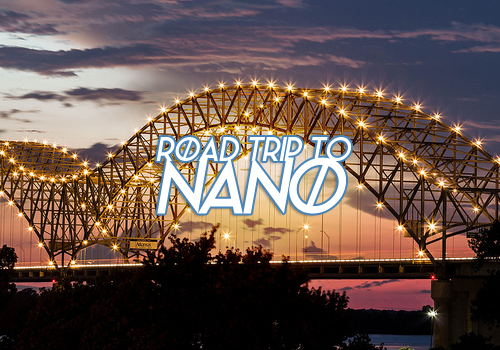
NaNoWriMo is an international event, and the stories being written every year reflect our hundreds of participating regions. We’re taking a Road Trip to NaNo to hear from our amazing writers all around the world. Today, Adrienne Devine, our Municipal Liaison in the Memphis region helps readers figure out a Plan B to get them through November:
Memphis, TN. Long thought to be primarily the home of the blues, in addition to some seriously great barbecue and a surprising number of indie creatives. Memphis is one part “We can do this,” another part “Let’s go the alternate route,” and a whole lot of overall “Let’s just do this” attitude.
If there’s one way to get something done, Memphis and her citizens have probably figured out a different way to get the same result. Memphians are always extremely proud of the fact that we went about doing things a different way…
One of the first things I learned after I moved to Memphis from my birthplace was that, one way or another, people in Memphis could get anything done—be it brewing coffee on the grill during the two week power outage caused by local storm Hurricane Elvis, or always hosting the “Memphis in May” festival come rain or shine.
I personally have bad wrists, and this always causes me problems near the end of the NaNoWriMo. It wasn’t until I looked at the situation from a Memphian point of view that I realized that my nearly 20,000-word deficit going into the last week didn’t mean I was going to lose. There was another way to get those words down without hurting myself.
I looked around and found Dragon Dictation software, which turned my spoken words into typed, on-screen ones. I then locked myself in my room for the duration of my usual writing time, and—between editing Dragon’s screw-ups and emailing myself little chunks at a time— I made up my deficit that year to win with ten words to spare.
Living in Memphis has taught me to always have a plan of attack. A plan for writing time, a plan for what happens when someone doesn’t respect your writing time, a plan for recovering your word count when distractions go on for too long. Make a plan, then go in and make a second plan.
One additional suggestion: go find yourself someone in your region that you can get along with. Make friends with them, and when you need some focused writing time, meet up with your new friend to “hang out”—then sprint or word war your way out of the word-count deficit. As any Memphian would tell you, you can do it!

Adrienne Devine, aka HuskersGirlLaura, has been doing NaNoWriMo since 2004. When she finally made the plunge into Memphis’ NaNoWriMo community in 2009, she was hooked: coming to the realization that she wanted to be an ML in order to give back to the organization that took her from ‘sorta-writing’ to actively writing non-stop. With obsessive levels of science fiction and fantasy knowledge she rarely ventures outside her usual genres, but she’s always up to help people in other genres work out the plot holes that they’ve inadvertently written themselves into.
Top photo by Flickr user Jeremy Sorrells
October 19, 2015
3 Reasons Why the Solitary Writer is a Myth

NaNo Prep season has begun in earnest. We’ve asked some writers to share their best tips on how to write the first draft of a novel and have fun doing it. Today, NaNoWriMo’s executive director, Grant Faulkner, shares just how a writing community can change your creative life:
Do you remember your first day of school? If you’re like me, you experienced a moment of trepidation just before you stepped into the room. You didn’t know who any of these people were. You didn’t know how they were going to receive you. And you didn’t want to be the uncomfortable loner marooned in a corner watching everyone else having fun together.
Here are two things I’ve learned over the years:
most people are nice and want to get to know you;once you make friends in that new community, you’re a better person for it.I say this because for years I kept writers’ communities at an arm’s distance, despite being a very diligent and determined writer. I guess I thought I could do it all myself, but I was also fearful of something—of rejection, of vulnerability, or of just being uncomfortable.
Now that I engage with several writing communities, however, I realize how they infuse me with a creative chutzpah that my lonely, dark garrett of a writing life never provided. I especially cherish the NaNo community’s rollicking, encouraging, whimsical, whip-cracking, jet-propelling spirit. NaNo’s community is all about helping everyone realize their creative dreams.
Here are the three simple reasons I think you should join in:
Creativity thrives in collaboration: None of us is as smart as all of us! Creations tend to emerge from a sequence of sparks lit by others—and your fellow NaNo writers form a whirling dervish of sparks.If you fall, you fall into others’ arms: Meeting regularly to write with others keeps you accountable. And if your main character decides to play dead, you’ll have a room full of other writers who will drop their pens to help you brainstorm “what if” scenarios.Sometimes you need commiseration or encouragement: NaNoWriMo can be an overwhelming beast. Only your fellow writers can understand why you’re more concerned about a character lost in a netherworld of darkness than your own lack of sleep, or when you’ve reached a milestone that deserves the crashing of cymbals.Writers thrive together. When C.S. Lewis met J.R.R. Tolkein, they were just two men with a “writing hobby”. They bonded over their interest in Nordic myths, formed a writing group called “The Inklings”, and guess what came next? Little books like The Hobbit and The Chronicles of Narnia.
This year’s theme of “the NaNoWriMo Library” represents not only the infinite reaches of the stories in your imagination, but the giant, wonderful community who gathers together for the love of storytelling.
So, if you haven’t gone to write-in, give it a whirl. The next time you hit a noveling hurdle, pose your question in the NaNo forums. Or jump start your word-count with one of the @NaNoWordSprints on Twitter. NaNoWriMo might be best described as the world’s biggest and best novel writing party, so join the revelry.
For more, I wrote an article in Writer’s Digest a year ago about some of the many ways NaNo’s community helps writers.

Grant Faulkner is the executive director of the nonprofit behind National Novel Writing Month. He received his B.A. from Grinnell College in English and his M.A. in Creative Writing from San Francisco State University. He has published stories and essays in The New York Times,Poets & Writers, Writer’s Digest, The Southwest Review, The Rumpus, Gargoyle, and The Berkeley Fiction Review, among dozens of others. He’s also the founder and editor of the lit journal 100 Word Story, and has published a collection of 100-word stories, Fissures.
Top photo by Flickr user masochismtango.
October 16, 2015
Young Writer Chronicles: Helping Students Discover Their Own Worlds
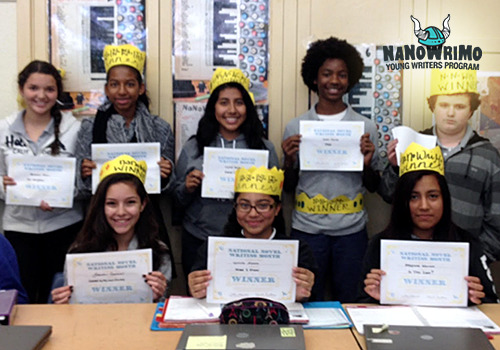
Every November, our Young Writers Program works with 100,000 students and educators, and 2,000 classrooms around the world. Today, Noriko Nakada, author and educator at Emerson Middle School in Los Angeles, shares how, every November, her students leave her classroom and enter the world of their novels:
The first time I participated in NaNoWriMo was as a writer, and at first I was hesitant to introduce novel writing to my students. I wondered if they could handle the intensity of the experience, but a fellow teacher and writer who had already led her class through the process urged me to try it.
That was six years ago, and November has easily become my favorite time in the school year. Students come into my class knowing they will have to write a novel, so we talk about it as we read and discuss books…
The last two weeks in October, we will work through some of the Middle School Workbook. The Good Book/Bad Book activity is always very helpful, but once students start to develop their characters with the character questionnaire, the momentum starts to build.
I also start collecting technology from around campus. AlphaSmart Neos and laptops make their way onto desks for the month. I always have students who choose to hand-write in composition books as well.

“Students leave my room and enter the world of their novels.”
My favorite moments are when students come to class and ask if they will have time to work on their novels. And then, even if they only have 15-20 minutes to write, the room goes silent except for the sound of words making their way onto the page. Students leave my room and enter the world of their novels. It is a privilege to be there for these creative moments.
I am also blown away when I read first paragraphs. Our students really know what novels sound like, which makes sense because they spend most of their reading time with novels, not essays or research papers. But the quality of the storytelling consistently leaves me in awe. Every year there are a few novels that I can’t stop reading.
“Write with your students.”
If you’re an educator thinking of bringing NaNoWriMo into your classroom, consider taking these steps:
Write with your students. Set a word count goal for yourself and participate along with them. Find resources like the YWP website to help you along. Order a classroom kit and chart your students’ progress. And those stickers and buttons really make a difference to students as they’re writing.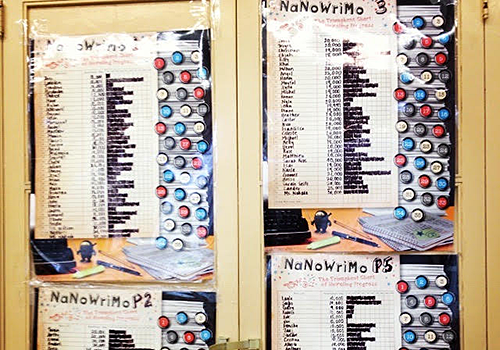 Use the pep talks to help yourself and your students. Don’t worry if you don’t get a whole lot of preparation in prior to November. Every story you and your students have read has given them the preparation they need. Help your students set word-count goals, create a plan for how many words they need to write daily, and ask about student word counts often. This helps them stay on track throughout the month. Give your students time to write in class and time to talk about their novels.
Use the pep talks to help yourself and your students. Don’t worry if you don’t get a whole lot of preparation in prior to November. Every story you and your students have read has given them the preparation they need. Help your students set word-count goals, create a plan for how many words they need to write daily, and ask about student word counts often. This helps them stay on track throughout the month. Give your students time to write in class and time to talk about their novels. It is a scary and crazy project, but just like the idea of writing a novel in a month, you will be amazed by what you are able to accomplish.

Noriko Nakada lives in Los Angeles where she writes and teaches at Emerson Middle School. She has published an early childhood memoir,
Through Eyes Like Mine
, and a middle school follow-up,
Overdue Apologies
.
Chris Baty's Blog
- Chris Baty's profile
- 63 followers



